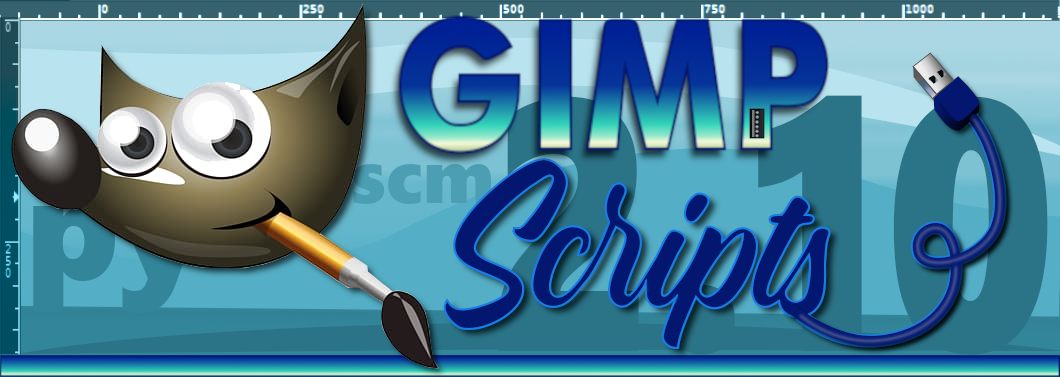Older versions and discussion on GimpChat: here.
Plugin-autotrace.py Ver 0.5
Authors: Lloyd Konneker (bootch) modification: MareroQ
Version 0.5 does not differ from version 0.4 except for the possibility of translating into any language ("po" file is included).
After you translate (in Gedit) you can send me your file and I will join the download.
After you translate (in Gedit) you can send me your file and I will join the download.
In menu Gimp: Filters/Edge-Detect/AutoTrace...
About the Plugin-autotrace.py:
About the Plugin-autotrace.py:
It has these main uses:
Simplifying an image to reduced colors and smooth outlines, like a cartoon or a collage.
Creating paths in an image, on outlines or centerlines.
It requires the separate program called autotrace. Autotrace is a command line program, available free on the web, with package name "autotrace".
It works by converting the image to vectors (curves), then back to pixels (a bitmap) and possibly paths (the Gimp name for vectors.)
The Plugin-autotrace.py plugin uses an engine (autotrace) that does poorly on fonts and line art.
How the Plugin-autotrace.py plugin works:
Saves the current image in a temporary bmp/ppm file.
Invokes autotrace on that file to create a temporary SVG file.
Imports the temporary svg file into a new image.
About Autotrace
Quoting the authors: AutoTrace is a program for converting bitmaps to vector graphics. The aim of the AutoTrace project is the development of a freely-available application similar
to CorelTrace or Adobe Streamline. In some aspects it is already better. Originally created as a plugin for the GIMP, AutoTrace is now a standalone program.
Simplifying an image to reduced colors and smooth outlines, like a cartoon or a collage.
Creating paths in an image, on outlines or centerlines.
It requires the separate program called autotrace. Autotrace is a command line program, available free on the web, with package name "autotrace".
It works by converting the image to vectors (curves), then back to pixels (a bitmap) and possibly paths (the Gimp name for vectors.)
The Plugin-autotrace.py plugin uses an engine (autotrace) that does poorly on fonts and line art.
How the Plugin-autotrace.py plugin works:
Saves the current image in a temporary bmp/ppm file.
Invokes autotrace on that file to create a temporary SVG file.
Imports the temporary svg file into a new image.
About Autotrace
Quoting the authors: AutoTrace is a program for converting bitmaps to vector graphics. The aim of the AutoTrace project is the development of a freely-available application similar
to CorelTrace or Adobe Streamline. In some aspects it is already better. Originally created as a plugin for the GIMP, AutoTrace is now a standalone program.
Home Page:
https://github.com/autotrace/autotrace/releases
Autotrace, in order:
1) despeckles, removing small features.
2) quantizes to a reduced color range.
3) vectorizes, using a "watershed" algorithm, tracing either outlines divides between colors (watersheds) or centerlines (rivers in watersheds).
The vectorizing step:
1) detects corners or cusps
2) fits curves (splines or Bezier curves) between the corners
The parameters of Autotrace affect one or more of these steps.
Gimp mainly uses bitmaps and Inkscape mainly uses vectors, but both have limited support for the other format.
Gimp will import vectors and Inkscape will import bitmaps.
You can find the SVG files created by the Plugin-autotrace.py plugin in the Gimp temporary directory.
I often read that in Gimp you won't do it ... and a piece of advice: use a different program.
Nothing could be more wrong - this plug is already 11 years old.
Autotrace, in order:
1) despeckles, removing small features.
2) quantizes to a reduced color range.
3) vectorizes, using a "watershed" algorithm, tracing either outlines divides between colors (watersheds) or centerlines (rivers in watersheds).
The vectorizing step:
1) detects corners or cusps
2) fits curves (splines or Bezier curves) between the corners
The parameters of Autotrace affect one or more of these steps.
Gimp mainly uses bitmaps and Inkscape mainly uses vectors, but both have limited support for the other format.
Gimp will import vectors and Inkscape will import bitmaps.
You can find the SVG files created by the Plugin-autotrace.py plugin in the Gimp temporary directory.
I often read that in Gimp you won't do it ... and a piece of advice: use a different program.
Nothing could be more wrong - this plug is already 11 years old.
________________________________________________________________________________
Known issue:
The SVG file is saved in the tmp directory (temporary folder) whose location is specified
in Edit / Preferences / Folder:
If the path in a directory name contains accented characters or spaces -
the svg file will not be created - you have to select a folder to save
in Preferences without these restrictions.Due to the described problems, I have made two changes:
1. Temporary files will be automatically saved only in the home directory in the subfolder "tmp".
2. The user must name temporary files (with a warning about not using spaces and special characters)
Plugin-autotrace.py Ver. 0.7
Change:
Save as BMP non-interactive (replace pdb.file_bmp_save to pdb.file_bmp_save2 )
Plugin-autotrace.py Ver. 0.8 with Preview
(June 28, 2023)
Created paths are not visible in Preview.
To get acquainted with created paths [Create paths=YES] use "Stroke path" option (choose in Gimp Tools: paint mode, foreground color and brush - size not too big).
The plugin does not conflict with non preview versions.
To get acquainted with created paths [Create paths=YES] use "Stroke path" option (choose in Gimp Tools: paint mode, foreground color and brush - size not too big).
The plugin does not conflict with non preview versions.
In menu: Filters ➤ Edge-Detect ➤ AutoTrace P...












No comments:
Post a Comment
Keep the tone of your comments civil and courteous. Keep in mind that there are no authors of plugins and scripts manning this site. Any comments posted for help or requests may go unanswered. Go to GimpChat.com and do a search instead.